Reliable Transaction Router
C++ Foundation
Classes
1.2.7 Stream Classes
For an added level of functionality, the RTRStream data class allows
for easier access to the data passed between the client and server
applications. This class provides methods with which you can read from
and write to the data buffer contained in RTRData. With these methods,
maintaining offset into the buffer is automatic.
The RTRStream class allows the serialization and deserialization of
objects. For example, if a client application called,
RTRStream::WriteToStream("WarandPeace");
RTRStream::WriteToStream("Tolstoy");
|
and a server then called,
RTRStream::ReadFromStream(pString1);
RTRStream::ReadFromStream(pString2);
|
pString1 would point to "WarandPeace" and after the second read,
pString2 would point to "Tolstoy."
For large amounts of data to be sent and received, a WriteToStream
method takes a void pointer to the length of the buffer.
1.2.8 Application Classes Summary
Figure 1-8 illustrates the client, data, and server classes in the
application classes and shows their parallelism. Data classes are
common to both client and server applications.
Figure 1-8 Application Classes
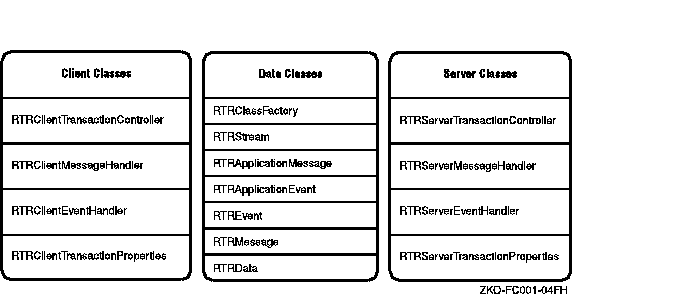
Table 1-1 shows application class categories and their descriptions.
Table 1-2 lists the application data classes that are common to both
client and server applications. Except for data classes, the class
categories describe the characteristics of the associated client and
server classes (for example, the Transaction Controller class category
in Table 1-1 describes the RTRServerTransactionController and
RTRClientTransactionController classes). For detailed descriptions of
individual foundation classes and their associated methods, see the
Application Classes chapter of this manual.
Table 1-1 Application Class Category Descriptions
| Class Category |
Description |
|
Transaction Controller
|
The transaction controller manages each transaction and also manages
the channels, messages, and events associated with that transaction.
- Has client and server versions.
- Manages each RTR transaction (1 transaction controller for each
transaction.).
- Controls at most one active transaction at a time.
- Can process many sequential transactions.
|
|
Transaction Properties
|
The RTRTransactionProperties class:
- Has client and server versions.
- Can be used by new or existing applications.
- Includes:
- GetTransactionState.
- SetTransactionState.
- GetInvocationType.
|
|
Event Handlers
|
Use RTREventHandler classes to obtain information about a transaction
such as whether a server is primary, standby or shadow.
The RTREventHandler class:
- Has client and server versions.
- Provides default implementation for every event.
- Enables the application to override only the events it wants to
process.
- Can be extended to have application-specific handlers such as
OnProcessOrder.
You must register an event handler with the RegisterHandlers method
in the TransactionController class.
|
|
Message Handlers
|
Message handlers can be used for all transactions and all application
data.
The RTRMessageHandler class:
- Has client and server versions.
- Provides default implementation for every message.
- Enables an application to override only the messages it wants to
process.
- Can be extended to have application-specific handlers.
RTRMessageHandler lets you override only messages you want to use.
For example, OnApplicationMessage can be implemented with
business-logic-specific objects such as OnStockBuy or OnStockSell.
|
Table 1-2 Data Class Descriptions
| Class Category |
Description |
|
RTRMessage
|
The RTRMessage class:
- Holds an RTR Message.
- Derives from the RTRData class.
- Is generated internally by RTR.
If an application has not registered a class factory, the
application calls the default class factory to allocate this object.
The application:
- Calls the Dispatch method to send this message to the appropriate
handler.
- Can optionally derive from RTRMessage to create a more
business-specific class.
|
|
RTREvent
|
The RTREvent class:
- Holds an RTR Event.
- Derives from the class RTRData.
- Is generated internally by RTR.
If an application has not registered a class factory, the
application calls the default class factory to allocate this object.
The application:
- Calls the Dispatch method to send this message to the appropriate
handler.
- Can optionally derive from RTREvent to create a more
business-specific class.
|
|
RTRData
|
The RTRData class is used to send and receive messages and events. It
is the abstract base class for the following four data classes:
- RTREvent
- RTRMessage
- RTRApplicationEvent
- RTRApplicationMessage
|
|
RTRApplicationMessage
|
The RTRApplicationMessage class:
- Holds an Application Message.
- Derives from class RTRStream.
- Is generated by a C++ API application.
- Can be treated as a stream to write and read the state of a higher
level object.
The application:
- Calls the Dispatch method to send this message to the appropriate
handler.
- Can optionally derive from RTRApplicationMessage to create a more
business-specific class.
|
|
RTRApplicationEvent
|
The RTRApplicationEvent class:
- Holds an application Event.
- Derives from the class RTRStream.
- Is generated by a C++ API application.
- Can be treated as a stream to write and read the state of a higher
level object.
The application:
- Calls the Dispatch method to send this message to the appropriate
handler.
- Can optionally derive from RTRApplicationMessage to create a more
business-specific class.
|
|
RTRStream
|
The RTRStream class:
- Derives from and extends the RTRData class
- Allows RTR applications to issue multiple read and write requests
to the memory buffer (managed by RTR).
- Automatically handles buffer pointer management
- Can be used to serialize and deserialize objects through RTR.
|
|
RTRClassFactory
|
The RTRClassFactory class creates instances of the data classes:
- RTRMessage
- RTREvent
- RTRApplicationMessage
- RTRApplicationEvent
An application registers its own class that is derived from the
RTRClassFactory and returns its own business level objects. If an
application does not register a customized version, by default, a class
factory object is internally created.
|
1.3 Management Classes
Management classes manage the environment in which an RTR application
executes, not the business-logic infrastructure of the application.
This allows you to do in a program what formerly had to be done at the
system management command level.
Facility Management
Managing facilities is based on three concepts provided as separate
foundation classes:
- Facility manager (RTRFacilityManager class)
A facility manager
creates and deletes facilities, and adds and removes facility members
based on facility name.
- Facility properties (RTRFacilityProperties class)
Facility
properties represent the information and properties of a single
facility.
- Facility member (RTRFacilityMember class)
Facility members
represent the individual members of a particular facility. A facility
member is both a role and a node combined, because a node can have more
than one role. For example, a nodename can represent three members by
being defined three times with the same node but with different roles
(backend, frontend, router).
For general information on RTR facilities, see RTR Getting
Started and the RTR System Manager's Manual.
Partitions and Key Segments
One of the benefits of the routing capability in RTR is that it enables
you to partition your data across multiple servers and nodes for
increased performance. Within an application, the partition determines
how messages are routed from clients to servers. RTR routes messages to
the correct partition on the basis of an application-defined key.
The contents of a message determine its destination. The router tracks
the location of data partitions and sends client messages to the
appropriate server for processing. The routing key, or key segment, is
embedded within the RTR message.
The foundation classes provide the object-oriented framework to
implement data partitioning with the following classes:
- Partition manager (RTRPartitionManager class)
A partition
manager creates and deletes partitions, and returns properties for
individual partitions based on partition name.
- Partition properties (RTRBackendPartitionProperties class)
Partition properties represent individual partitions within RTR and
provide statistics for a partition.
- Key segment (RTRKeySegment class)
A key segment object defines
the range of a partition.
An RTRKeySegment object specifies a data
key range and is associated with a partition when a Partition Manager
creates a partition.
Figure 1-9 illustrates the relationship between RTR entities and
partition classes. Partition classes refer to an RTR partition. As the
figure illustrates, the actual partition resides in RTR, not in the
foundation class objects. Methods within the partition classes can
create and delete partitions, and get partition properties for the RTR
partitions.
Figure 1-9 Partition Objects and RTR
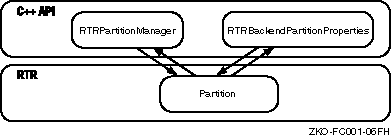
1.3.1 Management Classes Descriptions
Figure 1-10 shows the management class categories and their classes.
These classes can be used in new applications or integrated into
existing legacy applications.
Figure 1-10 Management Classes
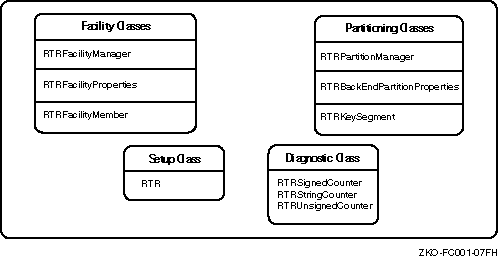
With the management classes, you can create a facility or a partition
programmatically instead of using the command language interface (CLI).
For legacy applications, you can write management routines to create
your application environment in an existing RTR C-language application.
Facility, management, and partition information exists in RTR. The
management classes access the information from RTR.
Table 1-3 describes the management classes. For detailed descriptions
of individual classes and their associated methods, see the Management
Classes chapter of this manual.
Table 1-3 Management Class Descriptions
| Class |
Description |
|
RTRFacilityManager
|
Is used to manage the creation, deletion, and viewing of facilities
based on facility name (existing RTR programs use facility names).
|
|
RTRFacilityMember
|
Represents a member of a particular facility. The member can be anynode
in the facility, including the local node.
Knows the relationship to the local node.
Provides member functions to evaluate connectivity. For example,
IsConnectedToLocalNode returns a boolean return to a query such as: "Is
node A connected to me?"
|
|
RTRFacilityProperties
|
Represents a single facility that exists within RTR.
Knows other members in the facility.
|
|
RTRPartitionManager
|
Manages the creation and deletion of partitions based on partition name.
|
|
RTRKeySegment
|
Defines and represents the key range of a partition associated with an
RTR server.
|
|
RTR
|
The RTR class represents RTR on the local node and performs actions
that apply to RTR as a whole including:
- Starting RTR.
- Stopping RTR.
- Creating a journal.
- Deleting a journal.
- Starting a web server.
- Stopping a web server.
|
|
RTRCounter
|
Enables an application to define and manipulate a counter within RTR.
They can be used within monitor screens to mix RTR and application
diagnostic information. RTRCounter is the base class for:
- RTRStringCounter
- RTRSignedCounter
- RTRUnsignedCounter
|
|
RTRBackendPartitionProperties
|
Supplies information about a partition, once it has been created.
Can be used by new or existing applications.
Can be used to obtain information on partitions created at the
command line or by the RTRPartitionManager.
Represents a single partition that exists within RTR. Since a
partition property object is not an actual partition but an object that
knows the properties of an RTR partition, if the partition is deleted,
the partition class points to nothing and returns an error.
Provides statistics for a partition.
|
1.4 Processing Models
You can use either of two processing models to implement client and
server applications. Depending on which processing model you use, you
implement the classes differently. The two processing models are:
Processing mechanisms are different for the polling and event-driven
models. With the polling model, when receiving the data object,
obtaining the RTR message value requires a GetMessageType call. With
event-driven processing, if you are using the handlers, a Receive
returns your states. Event-driven is an addition to the primitive
polling mechanism. By adding a call to Dispatch in the polling
mechanism in the application, you can enable default processing for all
messages and events.
Table 1-4 compares the two processing models. These comparisons apply
to both client and server. The sample application and code examples in
this book use event-driven processing in server applications, and
polling in client applications.
Table 1-4 Transaction Processing Models Compared
| Processing Method |
What You Get |
Programming Logic |
Message and Event Handling |
|
Event-Driven
|
Default handling of all RTR messages and events.
|
Create a loop containing Receive() and Dispatch() calls.
|
Messages and Events are handled by the MessageHandler and EventHandler
objects.
|
|
Polling
|
RTRData methods that allow for user-implemented detection of incoming
data and development of message and event handling.
|
Use RTRData methods to detect incoming data types. Develop logic to
handle all possible messages and events.
|
User-implemented logic in place of MessageHandler and EventHandler
classes.
|
1.4.1 Event-Driven Model
Figure 1-11 shows the steps in the event-driven model of transaction
processing as used in a server application.
Figure 1-11 Event-Driven Server Processing
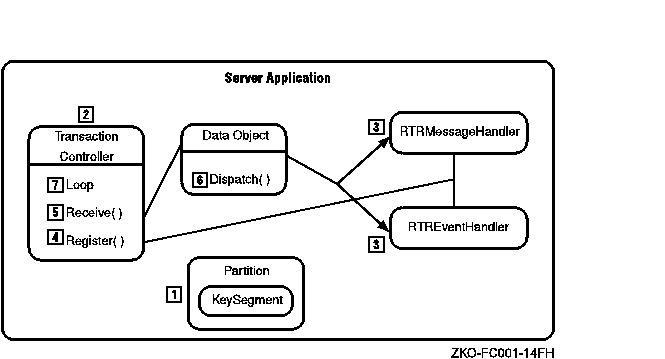
In the event-driven model, the application is informed when there is
something for it. RTR automatically sends messages to the server and
the server runs a transaction, using the Receive and Dispatch methods
within a while loop. Business logic resides in the message and event
handlers. The event-driven model is the recommended method for
implementing server applications.
As shown in Figure 1-11, the sequence of operations is as follows:
- Create an environment that has one or more partitions that are
defined in key segments.
- Create a TransactionController object.
- Create the handler classes derived from base classes. Business
logic resides in the message and event handlers.
- Call Register methods to register facility, class factory,
partition, and handlers. This internal hookup creates a mapping to the
message and event handlers.
- Start to receive information (messages or events) for the partition
registered to the ServerTransactionController by calling Receive, a
method on the ServerTransactionController. The class factory creates a
data object on the Receive call. The Transaction Controller receives
the data object.
- Call Dispatch. Dispatch knows which handler to go to.
User-implemented logic and methods are stored in the data object.
Checking for RTR-generated data, retrieving messages, and retrieving
events are all done for you automatically, if you call Dispatch. For
example, on a Receive call, if the message is
rtr_mt_msgn
, then calling Dispatch calls OnApplicationMessage by default.
OnApplicationMessage is a method in the RTRServerMessageHandler and
RTRClientMessageHandler classes.
Business logic is typically
implemented in the server message handler. However, you can implement
business logic in other ways as well.
- Loop for next event.
Event-Driven Processing
Using the event-driven model implements the following mechanism:
- Receive within a loop to receive a message or event.
- Call Dispatch.
The Data Object is passed on this call. All
handler methods have two parameters: a message type, and a pointer to
the TransactionController from which the message came. Data Objects,
which are stateless, are not tied to a TransactionController; they can
be handled by different TransactionControllers. Thus, using a
TransactionController does not restrict client applications.
- By default, the RTRData object automatically accesses the
appropriate Handler by the appropriate method, depending on the message
or event with the RTRClassFactory class. For example, if RTRData
contains RTR message type
rtr_mt_msgn
, then Dispatch calls OnApplicationMessage(RTRApplicationMessage).
- The Data Object is processed within the appropriate Handler. For
example, the RTRData object containing
rtr_mt_msgn
is processed by OnApplicationMessage. This is where the business logic
is typically implemented.
This sequence is shown in Figure 1-12.
Figure 1-12 Event-Driven Processing Example
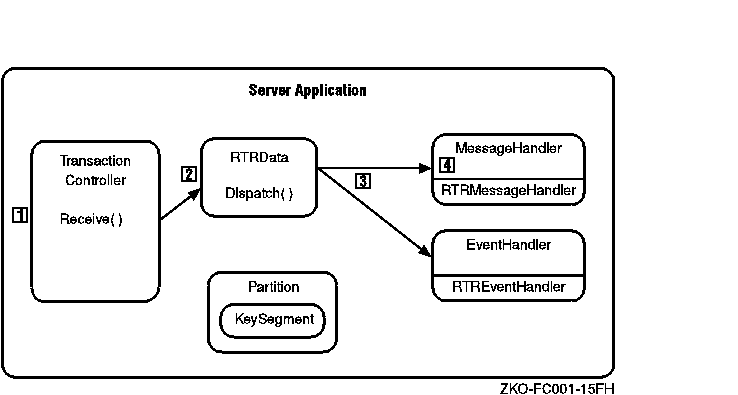
Message and Event Handling
This section provides event and message handling examples that are
processed based on what RTR message or event is received on a Receive
call. Depending on the message received, the subsequent process is
different, as shown in Table 1-5.
Table 1-5 Message and Event Handling Examples
| If the message received is: |
Then: |
|
rtr_mt_msgn
|
The Data Object goes to the Message Handler by the
OnApplicationMessage(Data Object) method. Then, in the Message Handler,
the Data Object is processed by OnApplicationMessage.
|
|
rtr_mt_rejected
|
The Data Object goes to the Message Handler using the OnRejected(Data
Object) method. Then, in the Message Handler, the Data Object is
processed by OnRejected.
|
|
rtr_mt_prepare
|
The Data Object is dispatched to be handled internally. Application
business logic does not need to know about RTR Prepares. In the C++
API, Prepares are transparent.
|
|
EVTNUM_SRPRIMARY
|
The Data Object goes to the Event Handler using the
OnServerIsPrimary(Data Object) method. Then, in the Event Handler, the
Data Object is processed by OnServerIsPrimary.
|
RTRMessageHandler and RTREventHandler are the default handlers.
Processing is done by an application's derived business logic. Default
handlers do not keep state, so the application must return to
BackendPartitionProperties to get state.
Event-Driven Example
Example 1-1 illustrates the looping implementation for event-driven
processing.
| Example 1-1 Example 1-1: Receive Loop |
ServerTransactionController ServerTransactionController;
RTRData *pDataBeingReceived = NULL;
while (true)
{
// Receive some data
ServerTransactionController.Receive(&pDataBeingReceived);
// No need to determine what we received.
// Just call Dispatch();
pDataBeingReceived->Dispatch();
}
|
1.4.2 Polling Model
Figure 1-13 shows the steps in the polling model of transaction
processing as used in a client application.
Figure 1-13 Polling Processing Model
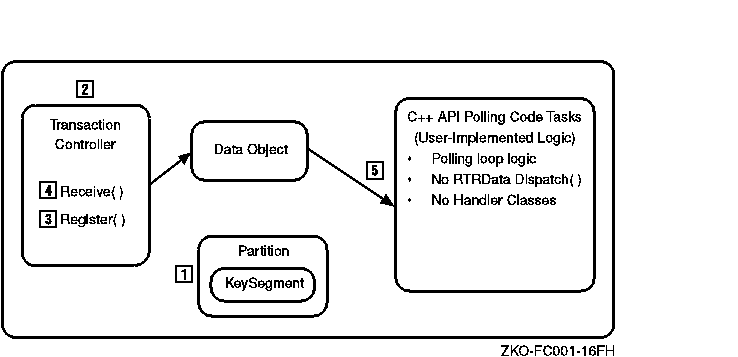
The polling model processing steps are:
- Create an environment that has one or more partitions defined in
key segments.
- Create a transaction controller object.
- Call Register methods to register facility (for client) and
partitions (for server) and class factory.
- Call Receive to check the data object.
- In place of Dispatch, start gathering information for the partition
on RTR by calling RTRData methods such as IsApplicationMessage,
IsMessage, and IsEvent (for a full listing of boolean RTRData methods,
see the Application Classes chapter of this manual) to determine what
type of data is being received in order to process it.
User-implemented logic handles all possible messages, events, and
serialized objects using RTRData methods.
- Call Receive again.
In the polling model, you create a receive loop to poll for incoming
data. Messages or events are received one at a time, and Register does
not connect message and event handlers. The server asks RTR for a
request.
You can still check the data object and code tasks as follows:
- Create the polling loop logic.
- In place of Dispatch, detect the incoming data type using the
RTRData methods IsApplicationData, IsMessage, and IsEvent. If you call
Dispatch, RTR responds that there are no handlers.
- In place of the Handler classes, you must develop logic to handle
all possible RTR and application messages, events, and serialized
objects using RTRData methods such as GetBuffer, GetMessageType, and
GetEventNumber. These methods are used in the Dispatch call.
As Figure 1-13 illustrates, in common with the event driven model, you
use a subset of the same objects, but Register does not connect the
message and event handlers.
Polling Model Example
Example 1-2 illustrates an implementation for the polling model of
processing. As this example illustrates, the flow is controlled by the
object that is polling for a message or event from RTR with Receive.
| Example 1-2 Polling Model Example |
ServerTransactionController ServerTransactionController;
RTRData *pDataBeingReceived = NULL;
while (true){
// Receive some data
ServerTransactionController.Receive(&pDataBeingReceived);
// Since handlers are not being used, determine what is
// received. Application-generated message or event.
// RTR-generated message or event.
if (true = pDataBeingReceived->IsApplicationMessage())
{
// Process accordingly
}
else
if (true = pDataBeingReceived->IsApplicationEvent())
{
// Process accordingly
}
else
if (true = pDataBeingReceived->IsRTRMessage())
{
// Process accordingly
}
else
if (true = pDataBeingReceived->IsRTREvent())
{
// Process accordingly
}
}
|





